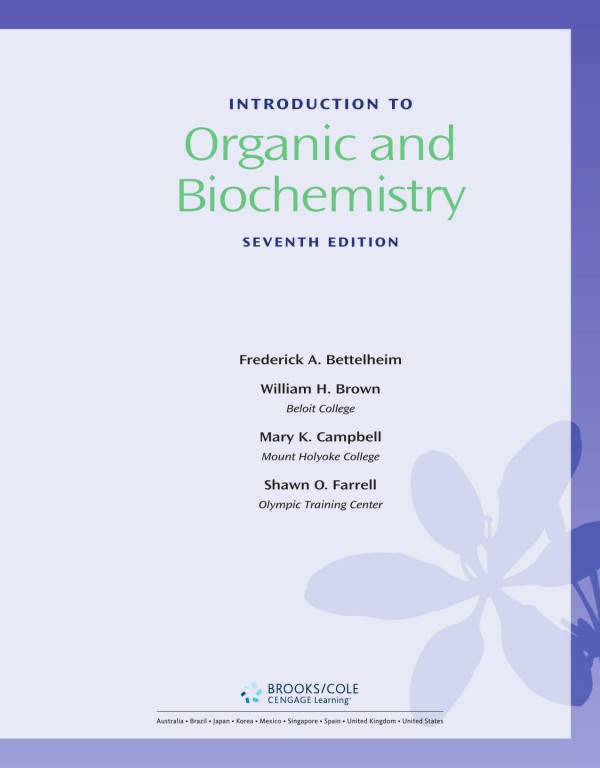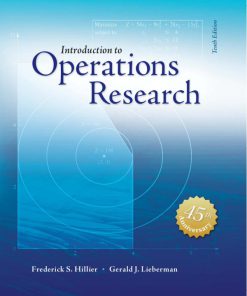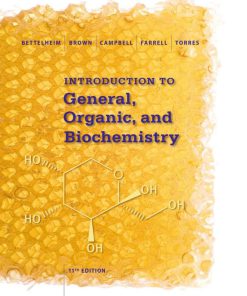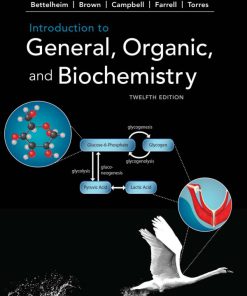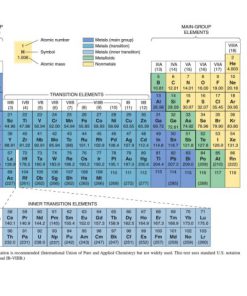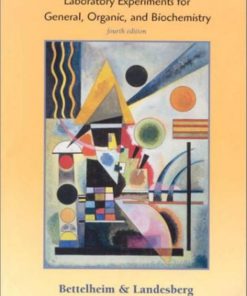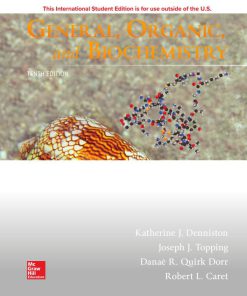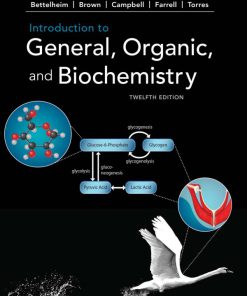Introduction to General Organic and Biochemistry 10th Edition by Frederick Bettelheim, William Brown, Mary Campbell 1133105084 9781133105084
$50.00 Original price was: $50.00.$25.00Current price is: $25.00.
Authors:Frederick A. Bettelheim; William H. Brown; Mary K. Campbell; Shawn O. Farrell; Omar Torres , Series:Biochemistry [63] , Tags:Science; Chemistry; General , Author sort:Bettelheim, Frederick A. & Brown, William H. & Campbell, Mary K. & Farrell, Shawn O. & Torres, Omar , Identifiers:Identifiers:isbn-13:978-0-495-39116-6 , Languages:Languages:eng , Published:Published:Jan 2010 , Publisher:Cengage Learning , Comments:Comments:This bestselling text continues to lead the way with a strong focus on current issues, pedagogically rich framework, wide variety of medical and biological applications, visually dynamic art program, and exceptionally strong and varied end-of-chapter problems. Revised and updated throughout, the eleventh edition now includes new biochemistry content, new Chemical Connections essays, new and revised problems, and more. Most end of chapter problems are now available in the OWLv2 online learning system. – See more at: http://www.cengage.com/search/productOverview.do?Ntt=bettelheim
Introduction to General Organic and Biochemistry 10th Edition by Frederick Bettelheim, William Brown, Mary Campbell – Ebook PDF Instant Download/Delivery. 1133105084, 9781133105084
Full download Introduction to General Organic and Biochemistry 10th Edition after payment
Product details:
ISBN 10: 1133105084
ISBN 13: 9781133105084
Author: Frederick A. Bettelheim; William H. Brown; Mary K. Campbell
This bestselling text continues to lead the way with a strong focus on current issues, pedagogically rich framework, wide variety of medical and biological applications, visually dynamic art program, and exceptionally strong and varied end-of-chapter problems. Revised and updated throughout, the tenth edition now includes new biochemistry content, new Chemical Connections essays, new and revised problems, and more. Most end of chapter problems are now available in the OWL online learning system.
Introduction to General Organic and Biochemistry 10th Table of contents:
Ch 1: Matter, Energy, and Measurement
1.1 Why do We Call Chemistry the Study of Matter?
1.2 What Is the Scientific Method?
1.3 How do Scientists Report Numbers?
1.4 How do We Make Measurements?
1.5 What Is a Handy Way to Convert from One Unit to Another?
1.6 What Are the States of Matter?
1.7 What Are Density and Specific Gravity?
1.8 How do We Describe the Various Forms of Energy?
1.9 How do We Describe Heat and the Ways in Which It is Transferred?
Summary
Problems
Ch 2: Atoms
2.1 What Is Matter Made Of?
2.2 How do We Classify Matter?
2.3 What Are the Postulates of Dalton’s Atomic Theory?
2.4 What Are Atoms Made Of?
2.5 What Is the Periodic Table?
2.6 How Are the Electrons in an Atom Arranged?
2.7 How Are Electron Configuration and Position in the Periodic Table Related?
2.8 What Is a Periodic Property?
Summary
Problems
Ch 3: Chemical Bonds
3.1 What do We Need to Know before We Begin?
3.2 What Is the Octet Rule?
3.3 How do We Name Anions and Cations?
3.4 What Are the Two Major Types of Chemical Bonds?
3.5 What Is an Ionic Bond?
3.6 How do We Name Ionic Compounds?
3.7 What Is a Covalent Bond?
3.8 How do We Name Binary Covalent Compounds?
3.9 What Is Resonance?
3.10 How do We Predict Bond Angles in Covalent Molecules?
3.11 How do We Determine If a Molecule Is Polar?
Summary
Problems
Ch 4: Chemical Reactions
4.1 What Is a Chemical Reaction?
4.2 How do We Balance Chemical Equations?
4.3 How can We Predict If Ions in Aqueous Solution will React with Each Other?
4.4 What Are Oxidation and Reduction?
4.5 What Are Formula Weights and Molecular Weights?
4.6 What Is a Mole and How Do We Use It to Calculate Mass Relationships?
4.7 How Do We Calculate Mass Relationships in Chemical Reactions?
4.8 What Is Heat of Reaction?
Summary
Problems
Ch 5: Gases, Liquids, and Solids
5.1 What Are the Three States of Matter?
5.2 What Is Gas Pressure and How do We Measure It?
5.3 What Are the Laws that Govern the Behavior of Gases?
5.4 What Are Avogadro’s Law and the Ideal Gas Law?
5.5 What Is Dalton’s Law of Partial Pressures?
5.6 What Is the Kinetic Molecular Theory?
5.7 What Types of Attractive Forces Exist between Molecules?
5.8 How do We Describe the Behavior of Liquids at the Molecular Level?
5.9 What Are the Characteristics of the Various Types of Solids?
5.10 What Is a Phase Change and What Energies are Involved?
Summary
Problems
Ch 6: Solutions and Colloids
6.1 What do We Need to Know as We Begin?
6.2 What Are the Most Common Types of Solutions?
6.3 What Are the Distinguishing Characteristics of Solutions?
6.4 What Factors Affect Solubility?
6.5 What Are the Most Common Units for Concentration?
6.6 Why Is Water Such a Good Solvent?
6.7 What Are Colloids?
6.8 What Is a Colligative Property?
Summary
Problems
Ch 7: Reaction Rates and Chemical Equilibrium
7.1 How do We Measure Reaction Rates?
7.2 Why do Some Molecular Collisions Result in Reaction Whereas Others Do Not?
7.3 What Is the Relationship between Activation Energy and Reaction Rate?
7.4 How can We Change the Rate of a Chemical Reaction?
7.5 What does It Mean to Say That a Reaction has Reached Equilibrium?
7.6 What Is an Equilibrium Constant and How do We Use It?
7.7 What Is Le Chatelier’s Principle?
Summary
Problems
Ch 8: Acids and Bases
8.1 What Are Acids and Bases?
8.2 How do We Define the Strength of Acids and Bases?
8.3 What Are Conjugate Acid-Base Pairs?
8.4 How can We Tell the Position of Equilibrium in an Acid-Base Reaction?
8.5 How do We Use Acid Ionization Constants?
8.6 What Are the Properties of Acids and Bases?
8.7 What Are the Acidic and Basic Properties of Pure Water?
8.8 What Are pH and pOH?
8.9 How do We Use Titrations to Calculate Concentration?
8.10 What Are Buffers?
8.11 How do We Calculate the pH of a Buffer?
8.12 What Are TRIS, HEPES, and These Buffers with the Strange Names?
Summary
Problems
Ch 9: Nuclear Chemistry
9.1 How was Radioactivity Discovered?
9.2 What Is Radioactivity?
9.3 What Happens When a Nucleus Emits Radioactivity?
9.4 What Is Nuclear Half-Life?
9.5 How do We Detect and Measure Nuclear Radiation?
9.6 How Is Radiation Dosimetry Related to Human Health?
9.7 What Is Nuclear Medicine?
9.8 What Is Nuclear Fusion?
9.9 What Is Nuclear Fission and How is It Related to Atomic Energy?
Summary of Key Questions
Summary of Key Reactions
Problems
Ch 10: Organic Chemistry
10.1 What Is Organic Chemistry?
10.2 Where do We Obtain Organic Compounds?
10.3 How do We Write Structural Formulas of Organic Compounds?
10.4 What Is a Functional Group?
Summary
Problems
Ch 11: Alkanes
11.1 What Are Alkanes?
11.2 How do We Write Structural Formulas of Alkanes?
11.3 What Are Constitutional Isomers?
11.4 How do We Name Alkanes?
11.5 Where do We Obtain Alkanes?
11.6 What Are Cycloalkanes?
11.7 What Are the Shapes of Alkanes and Cycloalkanes?
11.8 What Is Cis-Trans Isomerism in Cycloalkanes?
11.9 What Are the Physical Properties of Alkanes and Cycloalkanes?
11.10 What Are the Characteristic Reactions of Alkanes?
11.11 What Are Some Important Haloalkanes?
Summary of Key Questions
Summary of Key Reactions
Problems
Ch 12: Alkenes and Alkynes
12.1 What Are Alkenes and Alkynes?
12.2 What Are the Structures of Alkenes and Alkynes?
12.3 How do We Name Alkenes and Alkynes?
12.4 What Are the Physical Properties of Alkenes and Alkynes?
12.5 What Are the Characteristic Reactions of Alkenes?
12.6 What Are the Important Polymerization Reactions of Ethylene and Substituted Ethylenes?
Summary of Key Questions
Summary of Key Reactions
Problems
Ch 13: Benzene and Its Derivatives
13.1 What Is the Structure of Benzene?
13.2 How do We Name Aromatic Compounds?
13.3 What Are the Characteristic Reactions of Benzene and Its Derivatives?
13.4 What Are Phenols?
Summary of Key Questions
Summary of Key Reactions
Problems
Ch 14: Alcohols, Ethers, and Thiols
14.1 What Are the Structures, Names, and Physical Properties of Alcohols?
14.2 What Are the Characteristic Reactions of Alcohols?
14.3 What Are the Structures, Names, and Properties of Ethers?
14.4 What Are the Structures, Names, and Properties of Thiols?
14.5 What Are the Most Commercially Important Alcohols?
Summary of Key Questions
Summary of Key Reactions
Problems
Ch 15: Chirality: The Handedness of Molecules
15.1 What Is Enantiomerism?
15.2 How do We Specify the Configuration of a Stereocenter?
15.3 How Many Stereoisomers Are Possible for Molecules with Two or More Stereocenters?
15.4 What Is Optical Activity, and How is Chirality Detected in the Laboratory?
15.5 What Is the Significance of Chirality in the Biological World?
Summary
Problems
Ch 16: Amines
16.1 What Are Amines?
16.2 How do We Name Amines?
16.3 What Are the Physical Properties of Amines?
16.4 How do We Describe the Basicity of Amines?
16.5 What Are the Characteristic Reactions of Amines?
Summary of Key Questions
Summary of Key Reactions
Problems
Ch 17: Aldehydes and Ketones
17.1 What Are Aldehydes and Ketones?
17.2 How do We Name Aldehydes and Ketones?
17.3 What Are the Physical Properties of Aldehydes and Ketones?
17.4 What Are the Characteristic Reactions of Aldehydes and Ketones?
17.5 What Is Keto-Enol Tautomerism?
Summary of Key Questions
Summary of Key Reactions
Problems
Ch 18: Carboxylic Acids
18.1 What Are Carboxylic Acids?
18.2 How do We Name Carboxylic Acids?
18.3 What Are the Physical Properties of Carboxylic Acids?
18.4 What Are Soaps and Detergents?
18.5 What Are the Characteristic Reactions of Carboxylic Acids?
Summary of Key Questions
Summary of Key Reactions
Problems
Ch 19: Carboxylic Anhydrides, Esters, and Amides
19.1 What Are Carboxylic Anhydrides, Esters, and Amides?
19.2 How do We Prepare Esters?
19.3 How do We Prepare Amides?
19.4 What Are the Characteristic Reactions of Anhydrides, Esters, and Amides?
19.5 What Are Phosphoric Anhydrides and Phosphoric Esters?
19.6 What Is Step-Growth Polymerization?
Summary of Key Questions
Summary of Key Reactions
Problems
Ch 20: Carbohydrates
20.1 Carbohydrates: What Are Monosaccharides?
20.2 What Are the Cyclic Structures of Monosaccharides?
20.3 What Are the Characteristic Reactions of Monosaccharides?
20.4 What Are Disaccharides and Oligosaccharides?
20.5 What Are Polysaccharides?
20.6 What Are Acidic Polysaccharides?
Summary of Key Questions
Summary of Key Reactions
Problems
Ch 21: Lipids
21.1 What Are Lipids?
21.2 What Are the Structures of Triglycerides?
21.3 What Are Some Properties of Triglycerides?
21.4 What Are the Structures of Complex Lipids?
21.5 What Role do Lipids Play in the Structure of Membranes?
21.6 What Are Glycerophospholipids?
21.7 What Are Sphingolipids?
21.8 What Are Glycolipids?
21.9 What Are Steroids?
21.10 What Are Some of the Physiological Roles of Steroid Hormones?
21.11 What Are Bile Salts?
21.12 What Are Prostaglandins, Thromboxanes, and Leukotrienes?
Summary
Problems
Ch 22: Proteins
22.1 What Are the Many Functions of Proteins?
22.2 What Are Amino Acids?
22.3 What Are Zwitterions?
22.4 What Determines the Characteristics of Amino Acids?
22.5 What Are Uncommon Amino Acids?
22.6 How do Amino Acids Combine to Form Proteins?
22.7 What Are the Properties of Proteins?
22.8 What Is the Primary Structure of a Protein?
22.9 What Is the Secondary Structure of a Protein?
22.10 Interlude: How does the Presence of Transition Metals Affect the Structure of Proteins?
22.11 What Is the Tertiary Structure of a Protein?
22.12 What Is the Quaternary Structure of a Protein?
22.13 How Are Proteins Denatured?
Summary
Problems
Ch 23: Enzymes
23.1 What Are Enzymes?
23.2 How are Enzymes Named and Classified?
23.3 What is the Terminology Used with Enzymes?
23.4 What Factors Influence Enzyme Activity?
23.5 What Are the Mechanisms of Enzyme Action?
23.6 How are Enzymes Regulated?
23.7 How are Enzymes Used in Medicine?
23.8 What Are Transition-State Analogs and Designer Enzymes?
Summary
Problems
Ch 24: Chemical Communications: Neurotransmitters and Hormones
24.1 What Molecules are Involved in Chemical Communications?
24.2 How are Chemical Messengers Classified as Neurotransmitters and Hormones?
24.3 How does Acetylcholine Act as a Messenger?
24.4 What Amino Acids Act as Neurotransmitters?
24.5 What Are Adrenergic Messengers?
24.6 What Is the Role of Peptides in Chemical Communication?
24.7 How do Steroid Hormones Act as Messengers?
Summary
Problems
Ch 25: Nucleotides, Nucleic Acids, and Heredity
25.1 What Are the Molecules of Heredity?
25.2 What Are Nucleic Acids Made Of?
25.3 What Is the Structure of DNA and RNA?
25.4 What Are the Different Classes of RNA?
25.5 What Are Genes?
25.6 How is DNA Replicated?
25.7 How is DNA Repaired?
25.8 How do We Amplify DNA?
Summary
Problems
Ch 26: Gene Expression and Protein Synthesis
26.1 How does DNA Lead to RNA and Protein?
26.2 How is DNA Transcribed into RNA?
26.3 What Is the Role of RNA in Translation?
26.4 What Is the Genetic Code?
26.5 How is Protein Synthesized?
26.6 How are Genes Regulated?
26.7 What Are Mutations?
26.8 How and Why do We Manipulate DNA?
26.9 What Is Gene Therapy?
Summary
Problems
Ch 27: Bioenergetics: How the Body Converts Food to Energy
27.1 What Is Metabolism?
27.2 What Are Mitochondria and What Role do They Play in Metabolism?
27.3 What Are the Principal Compounds of the Common Metabolic Pathway?
27.4 What Role does the Citric Acid Cycle Play in Metabolism?
27.5 How do Electron and H+ Transport Take Place?
27.6 What Is the Role of the Chemiosmotic Pump in ATP Production?
27.7 What Is the Energy Yield Resulting from Electron and H+ Transport?
27.8 How is Chemical Energy Converted to Other Forms of Energy?
Summary
Problems
Ch 28: Specific Catabolic Pathways: Carbohydrate, Lipid, and Protein Metabolism
28.1 What Is the General Outline of Catabolic Pathways?
28.2 What Are the Reactions of Glycolysis?
28.3 What Is the Energy Yield from Glucose Catabolism?
28.4 How does Glycerol Catabolism Take Place?
28.5 What are the Reactions of B-Oxidation of Fatty Acids?
28.6 What Is the Energy Yield from Stearic Acid Catabolism?
28.7 What Are Ketone Bodies?
28.8 How is the Nitrogen of Amino Acids Processed in Catabolism?
28.9 How Are the Carbon Skeletons of Amino Acids Processed in Catabolism?
28.10 What Are the Reactions of Catabolism of Heme?
Summary
Problems
Ch 29: Biosynthetic Pathways
29.1 What Is the General Outline of Biosynthetic Pathways?
29.2 How does the Biosynthesis of Carbohydrates Take Place?
29.3 How does the Biosynthesis of Fatty Acids Take Place?
29.4 How does the Biosynthesis of Membrane Lipids Take Place?
29.5 How does the Biosynthesis of Amino Acids Take Place?
Summary
Problems
Ch 30: Nutrition
30.1 How do We Measure Nutrition?
30.2 Why do We Count Calories?
30.3 How does the Body Process Dietary Carbohydrates?
30.4 How does the Body Process Dietary Fats?
30.5 How does the Body Process Dietary Protein?
30.6 What Is the Importance of Vitamins, Minerals, and Water?
Summary
Problems
Ch 31: Immunochemistry
31.1 How does the Body Defend Itself from Invasion?
31.2 What Organs and Cells Make Up the Immune System?
31.3 How do Antigens Stimulate the Immune System?
31.4 What Are Immunoglobulins?
31.5 What Are T Cells and T-Cell Receptors?
31.6 How is the Immune Response Controlled?
31.7 Immunization
31.8 How does the Body Distinguish “Self” from “Nonself”?
31.9 How does the Human Immunodeficiency Virus Cause AIDS?
Summary
Problems
Ch 32: Body Fluids
32.1 What Are Some of the Important Body Fluids?
32.2 What Are the Functions and Composition of Blood?
32.3 How does Blood Serve as a Carrier of Oxygen?
32.4 How does the Transport of Carbon Dioxide in the Blood Take Place?
32.5 What Role do the Kidneys Play in Cleansing the Blood?
32.6 How do the Kidneys Play a Role in the Body’s Buffers?
32.7 How are Water and Salt Balance Maintained in the Blood and Kidneys?
32.8 What Are the Biochemistry and Physiology of Blood Pressure?
People also search for Introduction to General Organic and Biochemistry 10th:
introduction to chemistry general organic and biological v. 1.0
introduction to organic chemistry and biochemistry
introduction to general organic and biological chemistry
introduction to biochemistry questions and answers
You may also like…
eBook PDF
General Organic Biochemistry 1st edition by Denniston, Topping, Caret 1266748628 9781266748622

